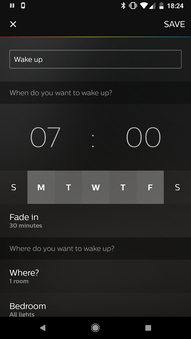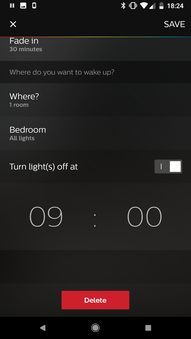How Does The Phillips Hue Wake-Up Feature Work?
I recently got myself a set of Phillips Hue White and Color Ambiance lights. One of the features I was looking forward to in particular (besides playing with all the color options) was setting a wake-up alarm with the lights gradually brightening. This was pretty painless to get set up using the phone app. I’m pretty happy with the result, but there’s certainly some things I wouldn’t mind tweaking. For example, the initial brightness of the bulbs (at the lowest setting) still seems a bit bright, so I might want to delay the bedside lamps and let the more distant lamp start fading in first. I also want to see if I can fiddle it into transitioning between some colors to get more of a sunrise effect (perhaps “rising” from the other side of the room, with the light spreading towards the head of the bed).
Figuring out how the wake-up settings that the app installed on my bridge seemed a good first step towards introducing my own customizations.
Information on getting access to a Hue bridge to make REST API calls to it can be found in the Hue API getting started guide.
My wake-up settings
My wake-up is scheduled for 7:00 to gradually brighten the lights with a half-hour fade-in each weekday. I also toggled on the setting to automatically turn the lights off at 9:00.


Finding things on the bridge
The most natural starting point is to check the schedules. Right off the bat, I find what I’m after:
The schedule …
GET http://bridge/api/${username}/schedules/1
{
"name": "Wake up",
"description": "L_04_fidlv_start wake up",
"command": {
"address": "/api/xxxxxxxxxxxxxxxxxxxxxxxxxxxxxxxxxxxxxxxx/sensors/2/state",
"body": {
"flag": true
},
"method": "PUT"
},
"localtime": "W124/T06:30:00",
"time": "W124/T10:30:00",
"created": "2018-03-11T19:46:54",
"status": "enabled",
"recycle": true
}
This is a recurring schedule item that runs every weekday at 6:30. We
can tell this by looking at the localtime field. From the
documentation on time patterns, we can see that it’s a recurring time
pattern specifying days of the week as a bitmask, and a time (6:30).
0MTWTFSS |
|---|
01111100 (124 in decimal) |
Since this schedule is enabled, we can be assured that it will run,
and in doing so, will issue a PUT to a sensors endpoint, setting a
flag to true.
… triggers the sensor …
GET http://bridge/api/${username}/sensors/2
{
"state": {
"flag": false,
"lastupdated": "2018-03-13T13:00:00"
},
"config": {
"on": true,
"reachable": true
},
"name": "Sensor for wakeup",
"type": "CLIPGenericFlag",
"modelid": "WAKEUP",
"manufacturername": "xxxxxxxxxxxxxxxxxxxxxxxxxxxxxxxx",
"swversion": "A_1801260942",
"uniqueid": "L_04_fidlv",
"recycle": true
}
The sensor is what’s really setting things in motion. Here we’ve got a generic CLIP flag sensor that is triggered exclusively by our schedule. Essentially, by updating the flag state, we trigger the sensor.
… triggers a rule …
GET http://bridge/api/${username}/rules/1
{
"name": "L_04_fidlv_Start",
"owner": "xxxxxxxxxxxxxxxxxxxxxxxxxxxxxxxxxxxxxxxx",
"created": "2018-03-11T19:46:51",
"lasttriggered": "2018-03-13T10:30:00",
"timestriggered": 2,
"status": "enabled",
"recycle": true,
"conditions": [
{
"address": "/sensors/2/state/flag",
"operator": "eq",
"value": "true"
}
],
"actions": [
{
"address": "/groups/1/action",
"method": "PUT",
"body": {
"scene": "7GJer2-5ahGIqz6"
}
},
{
"address": "/schedules/2",
"method": "PUT",
"body": {
"status": "enabled"
}
}
]
}
Now things are happening. Looking at the conditions, we can see that
this rule triggers when the wakeup sensor updates, and its flag is set
to true. When that happens, the bridge will iterate through its
rules, find that the above condition has been met, and iterate through
each of the actions.
… which sets the scene …
The bedroom group (/groups/1 in the rule’s action list) is set to
the following scene, which turns on the lights at minimum brightness:
GET http://bridge/api/${username}/scenes/7GJer2-5ahGIqz6
{
"name": "Wake Up init",
"lights": [
"2",
"3",
"5"
],
"owner": "xxxxxxxxxxxxxxxxxxxxxxxxxxxxxxxxxxxxxxxx",
"recycle": true,
"locked": true,
"appdata": {},
"picture": "",
"lastupdated": "2018-03-11T19:46:50",
"version": 2,
"lightstates": {
"2": {
"on": true,
"bri": 1,
"ct": 447
},
"3": {
"on": true,
"bri": 1,
"ct": 447
},
"5": {
"on": true,
"bri": 1,
"ct": 447
}
}
}
… and schedules the transition …
Another schedule (/schedules/2 in the rule’s action list) is enabled
by the rule.
GET http://bridge/api/${username}/schedules/2
{
"name": "L_04_fidlv",
"description": "L_04_fidlv_trigger end scene",
"command": {
"address": "/api/xxxxxxxxxxxxxxxxxxxxxxxxxxxxxxxxxxxxxxxx/groups/0/action",
"body": {
"scene": "gXdkB1um68N1sZL"
},
"method": "PUT"
},
"localtime": "PT00:01:00",
"time": "PT00:01:00",
"created": "2018-03-11T19:46:51",
"status": "disabled",
"autodelete": false,
"starttime": "2018-03-13T10:30:00",
"recycle": true
}
This schedule is a bit different from the one we saw before. It is
normally disabled, and it’s time pattern (in localtime) is
different. The PT prefix specifies that this is a timer which
expires after the given amount of time has passed. In this case, it is
set to one minute (the first 60 seconds of our wake-up will be spent
in minimal lighting). Enabling this schedule starts up the timer. When
one minute is up, another scene will be set.
This one, strangely, is applied to group 0, the meta-group including
all lights, but since the scene itself specifies to which lights it
applies, there’s no real problem with it.
… to a fully lit room …
GET http://bridge/api/${username}/scenes/gXdkB1um68N1sZL
{
"name": "Wake Up end",
"lights": [
"2",
"3",
"5"
],
"owner": "xxxxxxxxxxxxxxxxxxxxxxxxxxxxxxxxxxxxxxxx",
"recycle": true,
"locked": true,
"appdata": {},
"picture": "",
"lastupdated": "2018-03-11T19:46:51",
"version": 2,
"lightstates": {
"2": {
"on": true,
"bri": 254,
"ct": 447,
"transitiontime": 17400
},
"3": {
"on": true,
"bri": 254,
"ct": 447,
"transitiontime": 17400
},
"5": {
"on": true,
"bri": 254,
"ct": 447,
"transitiontime": 17400
}
}
}
This scene transitions the lights to full brightness over the next 29
minutes (1740 seconds), per the specified transitiontime (which is
specified in deciseconds).
… which will be switched off later.
Finally, an additional rule takes care of turning the lights off and the wake-up sensor at 9:00 (Two and a half hours after the initial triggering of the sensor).
GET http://bridge/api/${username}/rules/2
{
"name": "Wake up 1.end",
"owner": "xxxxxxxxxxxxxxxxxxxxxxxxxxxxxxxxxxxxxxxx",
"created": "2018-03-11T19:46:51",
"lasttriggered": "2018-03-13T13:00:00",
"timestriggered": 2,
"status": "enabled",
"recycle": true,
"conditions": [
{
"address": "/sensors/2/state/flag",
"operator": "eq",
"value": "true"
},
{
"address": "/sensors/2/state/flag",
"operator": "ddx",
"value": "PT02:30:00"
}
],
"actions": [
{
"address": "/groups/2/action",
"method": "PUT",
"body": {
"on": false
}
},
{
"address": "/sensors/2/state",
"method": "PUT",
"body": {
"flag": false
}
}
]
}
Unlike the first rule, this one doesn’t trigger immediately. It has an
additional condition on the sensor state flag using the special ddx
operator, which (given the timer specified) is true two and a half
hours after the flag has been set. As the schedule sets it at 6:30,
that means that this rule will trigger at 9:00, turn the lights off in
the bedroom, and set the sensor’s flag to false.
Where to go from here
The wake-up config in the phone app touched on pretty much every major aspect of the Hue bridge API. Given the insight I now have into how it works, I can start constructing my own schedules and transitions, and playing with different ways of triggering them and even having them trigger each other.
If I get around to building my rolling sunrise, I’ll be sure to get a post up on it :)